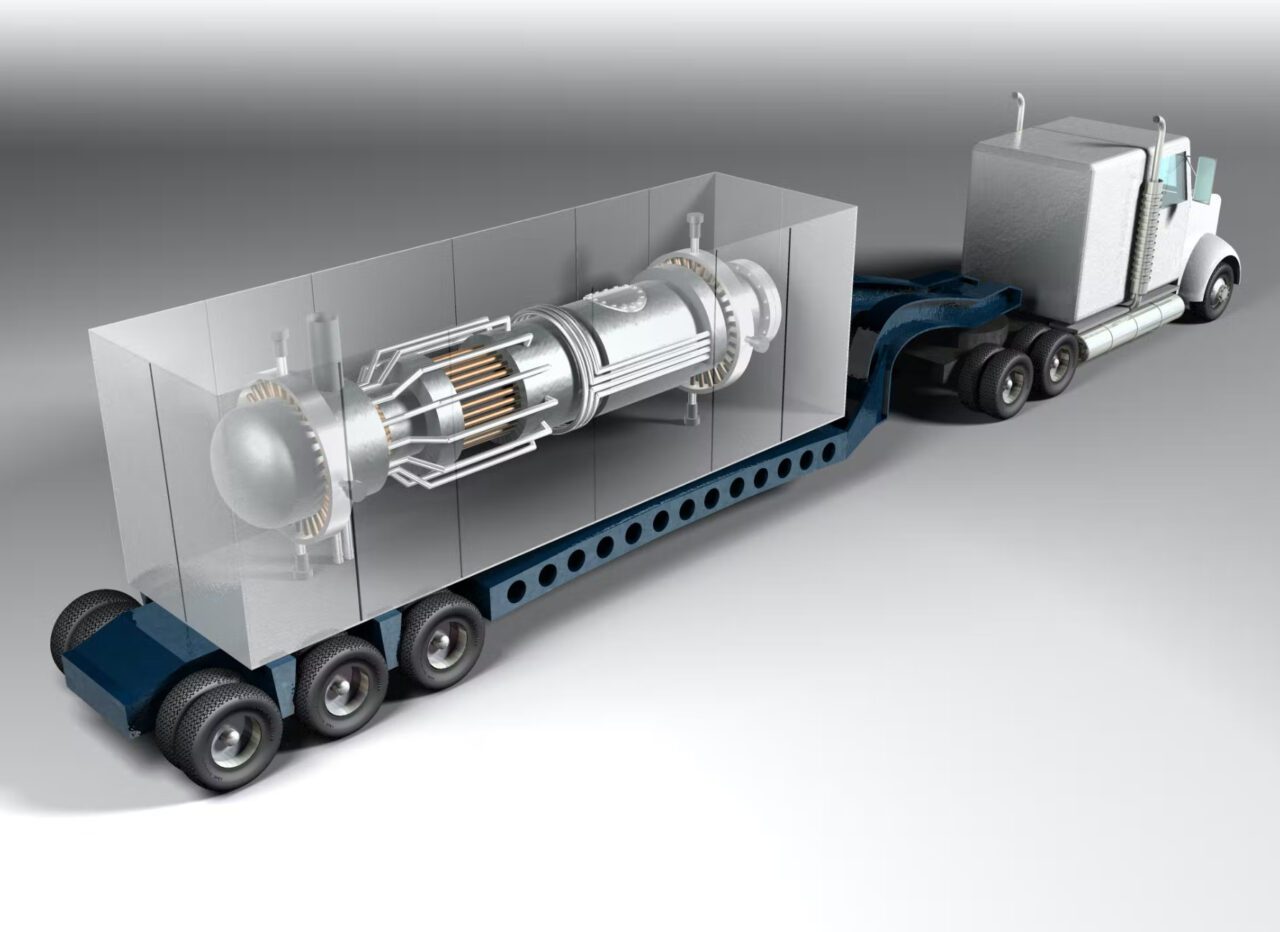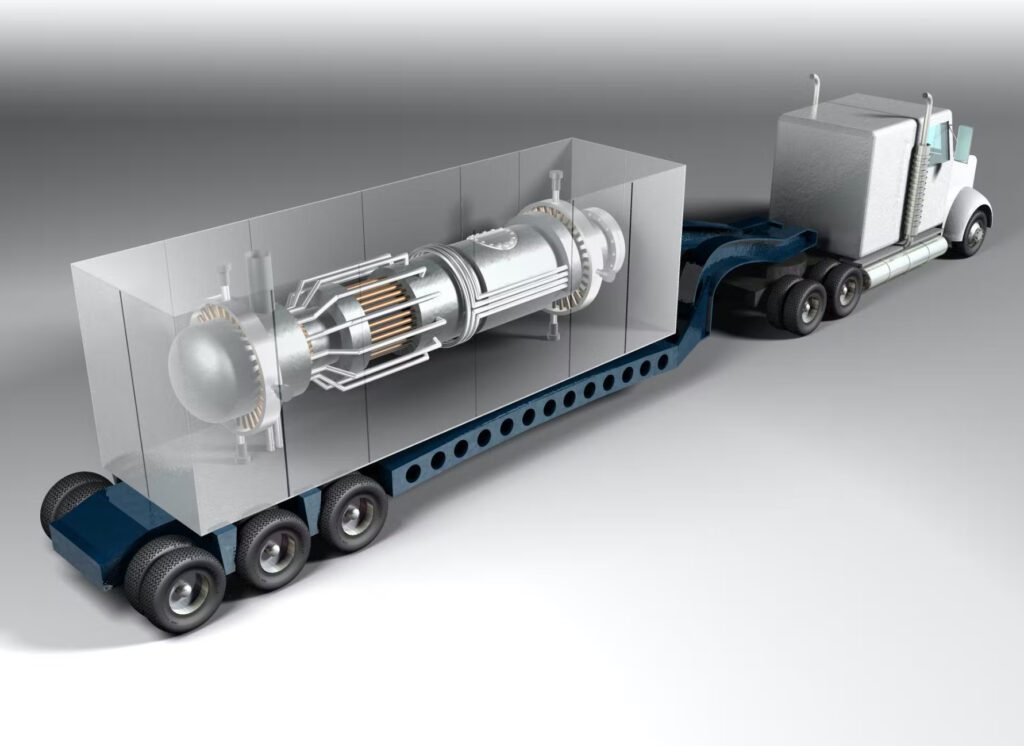Green Light for Project Pele, Defense Department’s Mobile Nuclear Microreactor Demonstration
Credit to Author: Sonal Patel| Date: Thu, 21 Apr 2022 17:29:06 +0000

The Department of Defense (DOD) will push forward on Project Pele, a much-watched mobile microreactor prototype, and demonstrate its full operation for a minimum of three years at an Idaho National Laboratory (INL) site.
The DOD’s Strategic Capabilities Office (SCO) on April 15 formally released a record of decision (ROD) to proceed with the program, following a two-year development period, which included efforts to prepare an environmental impact statement (EIS). The Environmental Protection Agency (EPA) concluded that process, publishing a notice of availability for the final EIS on Feb. 22.
Final Design Selection Coming Soon
The ROD indicates Project Pele will comprise a high-temperature gas-cooled (HTGR) mobile microreactor that will be capable of producing 1 MWe to 5 MWe. The SCO is still, however, considering two engineering designs selected as part of a preliminary design competition, which wrapped up in March 2021. These include an HTGR design from BWXT Advanced Technologies and X-energy’s Mobile Nuclear Power Plant.
“After a final design review in early 2022 and completion of [the final EIS under the National Environmental Policy Act (NEPA)], one of the two companies may be selected to build and demonstrate a mobile microreactor,” the final EIS notes. The SCO in a statement said that while it has “full confidence” that both teams have developed designs that can be built to meet SCO’s minimum technical requirements, the winning design will be “announced later this spring.”
Reactor fuel for the Project Pele demonstration is meanwhile slated to be produced from Department of Energy (DOE) stockpiles of highly enriched uranium (HEU) currently stored at the Y–12 National Security Complex in Oak Ridge, Tennessee, the ROD says. The fuel will be converted from a metal to an oxide at BWXT Technologies’ Nuclear Fuel Services facility in Erwin, Tennessee. It will then be down-blended to high-assay low-enriched uranium (HALEU) and fabricated into tristructural isotropic (TRISO) reactor fuel at the BWXT facility in Lynchburg, Virginia.
Project Pele’s final assembly, fuel loading, and demonstration of the operability and mobility (proof-of-concept) will be performed at the INL site using DOE technical expertise and facilities at the Materials and Fuels Complex (MFC) and the Critical Infrastructure Test Range Complex (CITRC). INL will also disassemble and transport the mobile microreactor, and transport it to temporary storage. INL could also potentially conduct mobile microreactor and spent nuclear fuel post-irradiation examination and disposition.
Demonstration activities, meanwhile, will comprise a wide range. Activities include startup testing, transportation between test locations, and testing at a second location at the INL site. “At the second testing location, the mobile microreactor system would be connected to a small, isolable electrical grid (microgrid) with diesel generators and load banks attached,” the final EIS notes. “The generators and load banks would apply realistic loads and supplies to the microgrid to test the mobile microreactor in a realistic setting.”
A Mobile HTGR Designed for the Military
The selected Project Pele HTGR design must achieve a few slated technical objectives, the SCO has said. First, “The uniqueness of the mobile microreactor of Project Pele is in the ability of the mobile microreactor packages to be transported by ship, rail, truck, or plane.” The microreactor must then also be able to generate threshold power for more than three years without refueling, and be capable of shutdown, cool down, and disconnect in less than seven days. Rapid startup is also a key factor: The SCO requires that the unit should be capable of starting up within less than 72 hours, timed from the point of the unit’s arrival to reaching full power operations.
The mobile microreactor should also have the capability to output 4160 VAC 3-phase electrical power at both 60 and 50 hertz—without specialized connections for connection to the electrical grid. In addition, “Heat rejection should require as little ancillary equipment and systems as necessary and should focus on convective heat transfer to ambient conditions, conduction heat transfer to surroundings, or a combination of both.” The final EIS notes that both reactor concepts under consideration employ a gas-driven turbine generator in the secondary coolant system to generate electrical power for power conversion.
However, size is also a key consideration: “All components should fit in ISO 688 certified 20- or 40-foot CONEX containers.” The government’s preference is to use 20-foot standard CONEX containers, it notes. Finally, the unit should have semi-autonomous operational capabilities, which should involve “minimal manning to monitor overall mobile microreactor and power plant system health.”

BWXT, X-energy Microreactor Concepts Under Consideration
Though the EIS-related NEPA process was initiated prior to the final design selection, the SCO says the analysis in the EIS will cover whichever design is selected for Project Pele.
As described in the final EIS, X-energy’s proposed concept, the “Mobile Nuclear Power Plant,” will employ a TRISO-fueled reactor coupled to a high-reliability power conversion system—“each contained in separate ISO-compliant containers to achieve maximum siting flexibility, limit hardware activation, and improve maintainability.”
BWXT Advanced Technologies’ proposed system is unnamed. The final EIS says it is “an HTGR design” that uses HALEU TRISO fuel and relies primarily on simple passive features and inherent physics to ensure safety.” However, the final EIS adds: “The mobile microreactor is capable of passive cooling and uses air as the ultimate heat sink; all excess heat generated by the mobile microreactor is transferred to the atmosphere without the need for any active components (e.g., pumps, blowers).” The BWXT microreactor will be coupled with a power conversion system that generates approximately 1 to 5 MWe using an open Brayton gas cycle. “The need for manual control of the systems is minimized as both the mobile microreactor and power conversion systems are managed by an advanced control system capable of semi-autonomous operation and safe shutdown of the system with no manual intervention,” the final EIS says.
Though neither BWXT nor X-energy have publicly unveiled their Project Pele concepts, each company is separately making progress on other mobile microreactor concepts that are focused on the commercial advanced reactor market.
BWXT is developing the 50-MWth BWXT Advanced Nuclear Reactor (BANR), a transportable microreactor that was selected as part of the DOE’s Advanced Reactor Demonstration Program (ARDP). The design is focused on using TRISO fuel particles to achieve higher uranium loading and an improved core design using a silicon carbide (SiC) matrix. BWXT Advanced Technologies says it has finalized its formal $106 million cost-sharing contracting with the DOE under the ARDP’s risk reduction pathway and is on track to deliver the first round of BANR’s TRISO fuel for testing at INL’s Advanced Test Reactor in 2024 as scheduled. BWXT, notably, is the only U.S. company to manufacture irradiation-tested uranium oxycarbide TRISO fuel using production-scale equipment.
X-energy, meanwhile, is developing the 7-MWe Xe-Mobile power generation system, which will use X-energy’s proprietary TRISO-X fuel. TRISO-X, an X-energy subsidiary dedicated to TRISO fuel manufacturing, on April 6 submitted the nation’s first HALEU fuel fabrication facility license to the Nuclear Regulatory Commission (NRC) for its TF3 facility, which it has proposed to build on a 110-acre lot in Oak Ridge, Tennessee. X-energy expects that the TF3, which is backed by the DOE’s ARDP program, will produce 8 metric tons of fuel per year (MTU/year), supporting about 16 advanced reactors—including X-energy’s larger 80-MWe (200-MWth) Xe-100 design, which it is also slated to demonstrate in Washington State as part of the DOE’s ARDP program by 2028. The NRC’s review of the TF3 application is expected to take 24 to 36 months, and issuance of the special nuclear material (SNM) license and operation of the TF3 is expected in the 2025 timeframe. The TRISO-X team ultimately wants to expand the TF3 facility’s capacity to 16 MTU/year by the early 2030s.
A Congressional Deadline: December 2027
The DOD’s efforts with Project Pele, however, appear carefully tailored to defense-related applications and timeframes. Project Pele stems from the 2019 National Defense Authorization Act, in which Congress directed the DOD and the DOE to develop a plan to design, build, and test a microreactor at a DOD installation no later than December 2027.
The recommendation came from a 2016 Defense Science Board finding that field military energy usage was slated to dramatically increase. Very small modular reactors with outputs of less than 10 MWe may be transportable and deployable at Forward Operating Bases, Remote Operating Bases, and Expeditionary Bases, and could eliminate the need for fuel otherwise dedicated to producing electrical power, it found.
“The DOD uses approximately 30 TWh of electricity per year and more than 10 million gallons of fuel per day—levels that are only expected to increase due to anticipated electrification of the non-tactical vehicle fleet and maturation of future energy-intensive capabilities,” the DOD said last week. “A safe, small, transportable nuclear reactor would address this growing demand with a resilient, carbon-free energy source that would not add to the DoD’s fuel needs, while supporting mission-critical operations in remote and austere environments.”
Project Pele, however, is to be a single prototype, which will be demonstrated only within the U.S. “A decision by the DoD on whether or not to transition the technology and to use it operationally will be made at a future date,” the DOD said.
Still, the agency suggested that given its “whole-of-government” effort, Project Pele could have a larger role to play as a technology pioneer. “As a High-Temperature Gas Reactor using HALEU TRISO fuel, Project Pele is a fourth-generation nuclear reactor, which can serve as a pathfinder for commercial adoption of such technologies, thereby reducing the nation’s carbon emissions and providing new tools for disaster relief and critical infrastructure support,” it said.
—Sonal Patel is a POWER senior associate editor (@sonalcpatel, @POWERmagazine).
The post Green Light for Project Pele, Defense Department’s Mobile Nuclear Microreactor Demonstration appeared first on POWER Magazine.